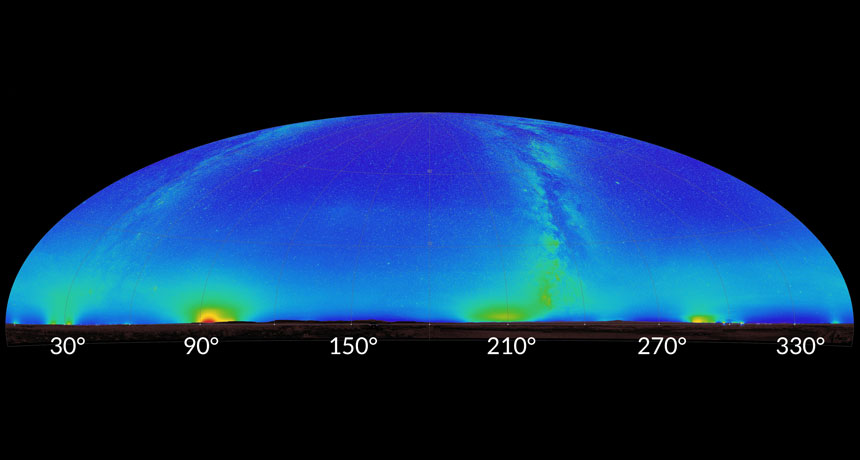
SKY GLOW This panoramic view of the night sky from Meteor Crater in Arizona shows how light from Winslow, Phoenix and Flagstaff (left to right, starting at 90°) makes it harder to see the stars.
Dan Duriscoe/National Park Service
OXON HILL, Md. — Even as technological advances allow astronomers to peer more deeply into the cosmos than ever before, new technologies also have the potential to create blinding pollution.
Three sources of pollution — space debris, radio interference and light pollution — already are particularly worrisome. And the situation is getting worse. In the next two decades, as many as 20,000 satellites could be launched into low Earth orbit, LEDs will become the dominant source of artificial light, and fifth-generation mobile networks will fill radio frequencies, speakers warned during the annual meeting of the American Astronomical Society. These sources of pollution could prevent astronomers from getting a clear look at the night sky, limiting the sensitivity and accuracy of their measurements.
Space debris is perhaps the most nascent form of human pollution. But only six decades after Sputnik’s launch into pristine skies, the orbit around Earth is now filled with nearly 18,000 objects tracked by the United States Strategic Command. These objects range in size from about centimeter-long chunks of material to bus-sized satellites. Space debris can both damage existing space telescopes and reflect light, potentially confusing terrestrial telescopes. From Earth, a glint of light could be a distant star or just a hunk of metal.
“The worst is yet to come,” said Patrick Seitzer, an astronomer at the University of Michigan in Ann Arbor. “We’re going to double our catalog [of debris] over the next 20 years.” Aerospace company Boeing, for instance, has proposed launching a global network of nearly 3,000 satellites. Collisions between any two satellites can create thousands of pieces of debris.
Down on Earth, light pollution is a well-known phenomenon (SN: 7/9/16, p. 32) and the shift to LEDs, or light-emitting diodes, is worsening the problem. In 2010, LEDs constituted less than 1 percent of the American lighting market. Today, they account for about half of the market, and that share is expected to grow.
LEDs have environmental and economic benefits, being long-lived and energy efficient. But they emit a broad spectrum of light, including blue-rich light, which is particularly bad for astronomy. Blue-rich light scatters more easily than light with longer wavelengths, like yellow, which worsens sky glow and makes it tougher to see stars.
Invisible to the naked eye, radio frequency interference is no less detrimental to astronomy than optical light pollution. For astronomers who observe the universe through radio waves generated by stars and galaxies, interference from an Earth-based source can easily drown out any far-off signal.
Just as radio channels close to each other in frequency can bleed into one another, creating static, so too can radio interference from different technologies bleed into the channels astronomers use to observe. As more and more space on the spectrum is gobbled up by new technology such as 5G mobile networks, radio astronomers will have to grapple with more potential interference. For instance, radar on driverless cars could affect radio astronomy operations up to 100 kilometers away, said Harvey Liszt, a radio astronomer at the National Radio Astronomy Observatory in Charlottesville, Va.
Faced with the prospect of encroaching technology on Earth, the late astronomer Jean Heidmann proposed in 1998 designating an area on the far side of the moon for an observatory that would be safe from space debris, light and radio pollution.
Short of that extreme solution, continuing government regulation of radio frequencies is crucial. “Without spectrum protection, radio astronomers would lose the ability to observe,” Liszt said. Astronomers may need to expand and secure radio quiet zones like the one surrounding the Green Bank Observatory in West Virginia to preserve a future for Earth-based radio astronomy.
When it comes to artificial light, none would be best. That’s a futile fight, astronomers agreed, but there are solutions. Flagstaff, Ariz., is adopting LED lights, but they are what’s called narrow-band amber LEDs, which limit sky glow because they resemble the yellow, low-pressure sodium lights astronomers prefer.
“Dark skies have become part of the culture here,” said astronomer Jeff Hall, director of the Lowell Observatory in Flagstaff. “It’s … a community value. We even have a company called Dark Sky Brewing.”
For now, many astronomers hope that such down-to-earth solutions to pollution will work.







